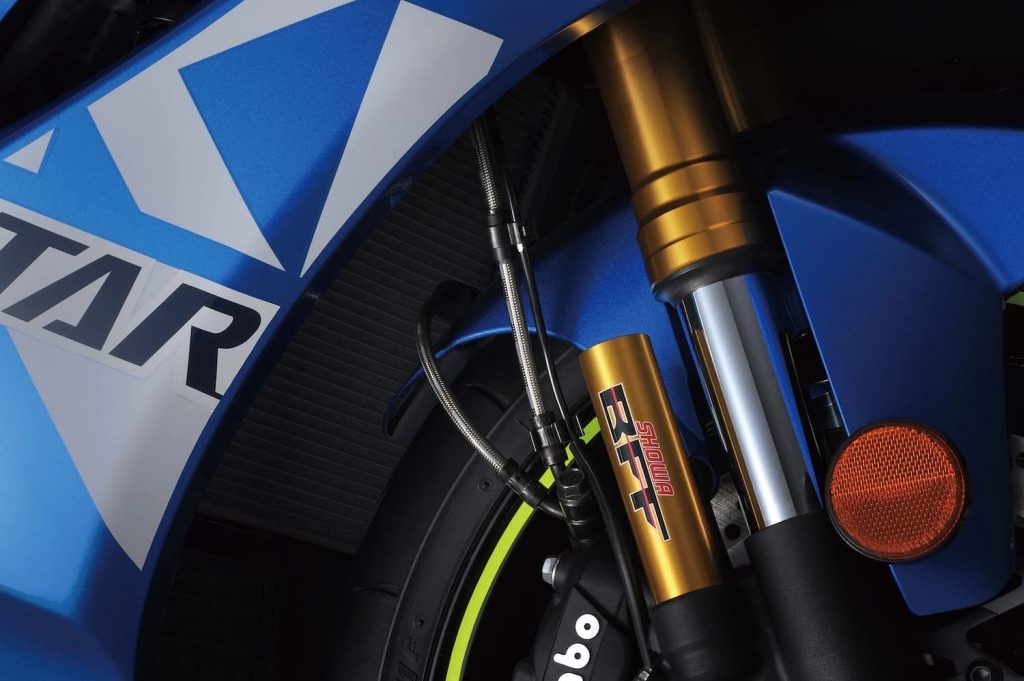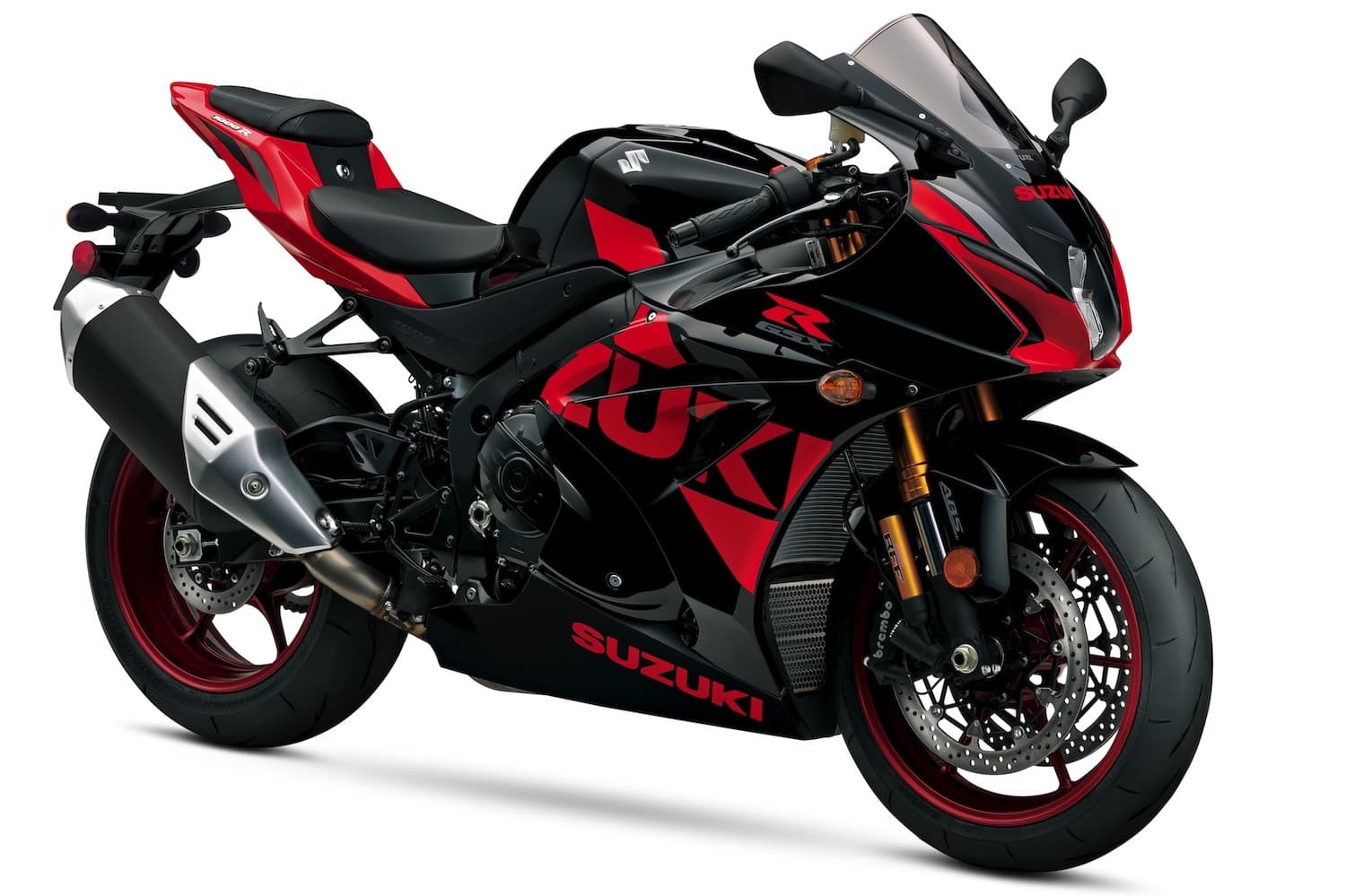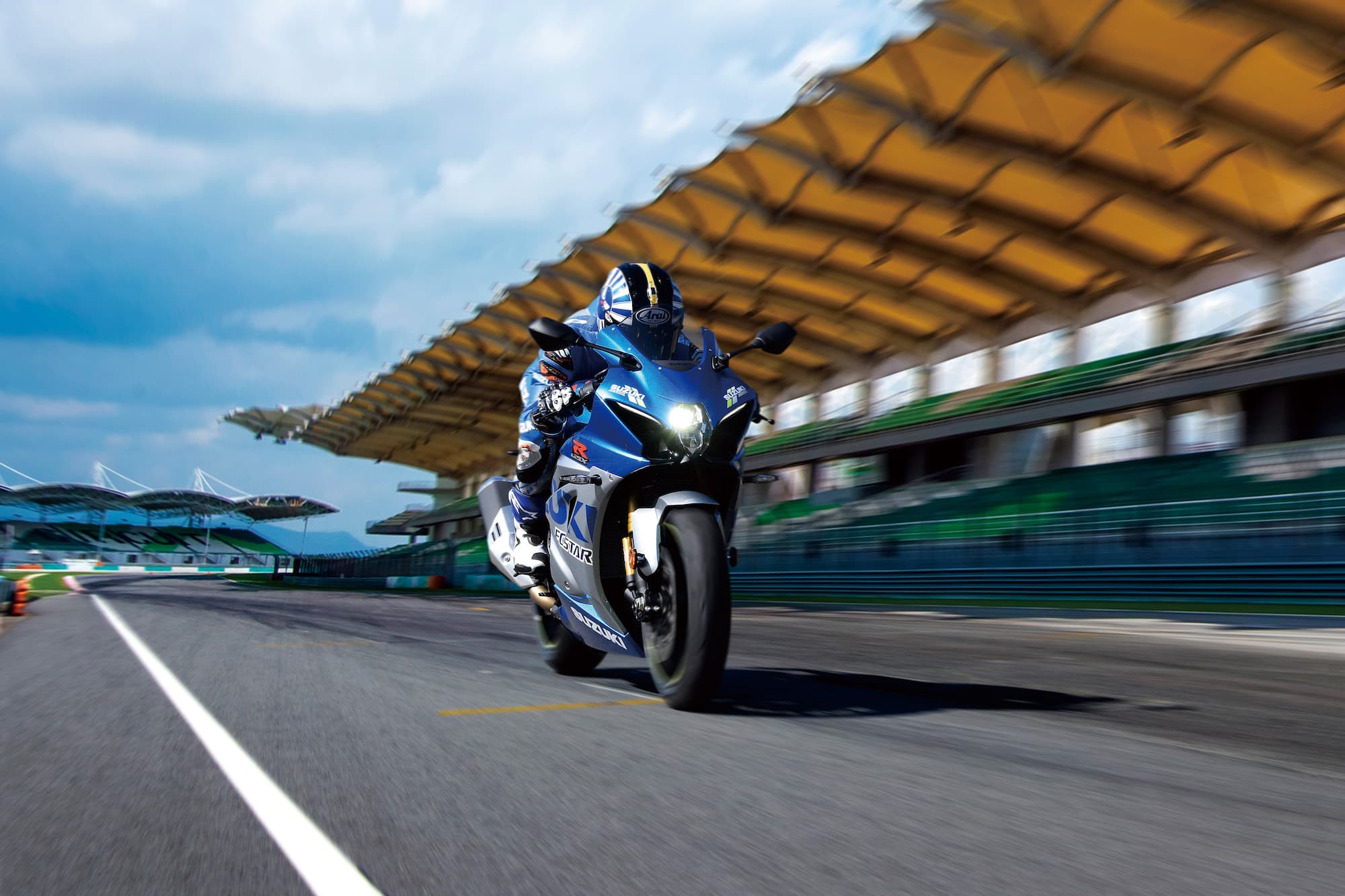Suzuki GSX-R1000 L7 (2017+) Maintenance Schedule and Service Intervals
This is the maintenance schedule and associated service intervals for the Suzuki GSX-R1000 L7 (2017-2021), the current model of the GSX-R1000 as of 2021.
The Suzuki GSX-R1000 is a sport bike from Suzuki’s iconic GSX-R or “Gixxer” series. The GSX-R1000 was originally introduced in 2001 to replace the GSX-R1100. But Suzuki brought down the capacity, bringing it closer to 1000cc (originally 988cc, but increased to 999cc from the K5 GSX-R1000 in 2005).
Here are the maintenance schedules for the various generations of Suzuki GSX-R1000:
- 2001-2004 Suzuki GSX-R1000 — 988 cc engine, single round exhaust. K3-4 has a 32-bit ECU and 4 piston radial-mounted calipers, under 120 kW (161 hp) @ 10800 rpm
- 2005-2008 Suzuki GSX-R1000 — 999 cc engine from wider bore.Titanium valves, lightweight pistons, slipper clutch. Trapezoidal exhaust. 2007-2008 has heavier dual exhausts. More power (131 kW @ 11000 rpm). Slight power bump in 2007 to 134 kW (182 hp) @ 12000 rpm.
- 2009-2011 Suzuki GSX-R1000 — New more over-square engine, redesigned fork, still dual exhausts. Same power as 2007.
- 2012-2016 Suzuki GSX-R1000 — Lighter pistons, revised cams. Ride modes. ABS from 2014. Brembo calipers. Similar power. Single exhaust.
- 2017+ Suzuki GSX-R1000 and GSX-R1000R — RBW, IMU, more power (148.6 kW / 199.2 hp @ 13200 rpm)
Suzuki released the latest 2017 model at EICMA in 2016. It’s the first major redesign of the Gixxer’s 999cc engine since 2009. The 2017 model has a higher RPM limit and no balancer shaft to quell vibration. The 2017 Suzuki GSX-R1000 is also the first with an IMU to manage ABS and traction control.
Suzuki also released the even racier GSX-R1000R with a few additions like the Motion Track Brake system, a bi-directional quick-shifter, and launch control. The R model also have Showa Balance Free Forks and Balance Free Rear Cushion that come standard on the 2016+ Kawasaki ZX-10R. The GSX-R1000R’s maintenance schedule is the same as that of the standard GSX-R1000.
This was originally published February 11, 2021, but has been significantly updated since.
This site has links for things like oil and spark plugs from which we earn a commission (which unfortunately nobody can save, not even us). If you appreciate this work, then please use those links. Thanks!
Suzuki GSX-R1000 Service Intervals
Overall, the Suzuki GSX-R1000 has 3500 mile / 6000 km service intervals. At every service, change the oil, and do a host of other checks for leaks, smooth operation, and correct lubrication.
Suzuki recommends more checks every two services, and the major valve inspection check every 14500 mi / 24000 km.
Since the GSX-R1000 has a liquid-cooled engine, make sure the coolant is kept up to spec. Suzuki recommends changing the long-life coolant every four years OR at 29000 miles / 48000 km.
What you need to service the L7 GSX-R1000
Aside from basic motorcycle maintenance tools, here is what you generally need to service your Suzuki GSX-R1000 L7, according to the manual.
| Part | 2017+ GSX-R1000 Spec |
|---|---|
| Engine oil | Suzuki recommends SAE 10W-40 or 10W-50 engine oil that meets JASO T903 spec MA, or API grade SG or higher. Suzuki recommends Suzuki Performance 4 Motor Oil, or an alternative high-quality oil like Motul 7100 10W-40. |
| Oil filter | Standard part for the oil filter is 16510-07J00. Aftermarket HifloFiltro part is HF138RC. |
| Spark plug | Use either an NGK CR9EIA-9 or Denso IU27D spark plug. |
| Air filter | Part number for the L7 air cleaner is 13780-44H00. The DNA high-performance aftermarket air filter is a popular replacement (P-S10S17-01). |
| Brake pads | The GSX-R1000 2017+ has a Brembo front caliper on 320mm discs. Standard part numbers for front and rear pads are 59100-14870 and 69100-47830, and EBC aftermarket HH pads are FA447HH and FA436HH. |
| Brake fluid | Use only DOT 4 fluid, e.g. Castrol DOT 4. |
| Chain maintenance | Maintain your chain with a simple low-mess lube like Motul chain paste. |
| General lubrication | Use Lithium soap-based grease for general lubrication. |
Suzuki GSX-R1000 L7 (2017-2021) Maintenance Schedule
Below is the maintenance schedule for the Suzuki GSX-R1000 L7 (2017+) as well as the GSX-R1000R.
Maintaining your GSX-R1000 L7 is not significantly different from previous generations, or indeed from other sport bikes! You have four cylinders, a liquid-cooled engine, a chain, and the regular number of brake pads.
Core things to remember are
- Lube and clean your chain regularly (just stop it from rusting!)
- Change the oil and filter sometimes
- Grease external pivot points to stop them from sticking.
There you go. Major work done.
Notes on reading this maintenance schedule:
- Interval: This interval should be judged by number of months or odometer reading, whichever comes first.
- I= Inspect and clean, adjust, replace or lubricate as necessary.
- R= Replace
- T= Tighten
- CA only items: these items’ maintenance intervals only apply to the California models.
| Months | 2 | 12 | 24 | 36 | 48 | |
|---|---|---|---|---|---|---|
| km x 1000 | 1 | 6 | 12 | 18 | 24 | |
| mi x 1000 | 6 | 4 | 7.5 | 11 | 14.5 | Other period |
| Engine oil (High-grade, e.g. Motul 7100 10W-40) | R | R | R | R | R | |
| Engine oil filter (HF138RC) | R | – | R | – | R | |
| Spark plugs (NGK CR9EIA-9 iridium plugs) | I | – | R | – | R | |
| Air cleaner element (SU-1017) | – | I | I | R | I | |
| Valve clearance | – | – | – | – | I | Inspect every 24K km (14.5K mi) |
| Radiator hose / cooling system | – | I | I | I | I | |
| Engine coolant (blue variety “Super long life”, e.g. Pro Honda HP Coolant) | – | – | – | – | R | Replace every 4 years or 48,000 km (29,000 miles) |
| Brakes (including pads) | I | I | I | I | I | |
| Brake hoses (leaks, kinks) | – | I | I | I | I | Replace every 4 years |
| Brake fluid (Castrol DOT 4) | – | I | I | I | I | Replace every 2 years |
| Exhaust pipe bolts and muffler bolts | T | – | T | – | T | |
| Exhaust control valve | I | I | I | I | I | |
| Fuel hose | – | I | I | I | I | |
| Evaporative emission control system | – | – | I | – | I | |
| Throttle cable play | I | I | I | I | I | |
| PAIR (air supply) system | – | – | I | – | I | |
| Throttle valve synchronization | – | – | I | – | I | |
| Clutch cable play | – | I | I | I | I | |
| Tires | – | I | I | I | I | |
| Steering | I | – | I | – | I | |
| Front forks | – | – | I | – | I | |
| Rear suspension | – | – | I | – | I | |
| Chassis bolts and nuts | T | T | T | T | T | |
| Lubrication (Lithium soap-based grease) | Lubricate every 1,000 km (600 miles) |
Maintaining your Chain on your Suzuki GSX-R1000
Maintain your chain regularly. Either use a good-quality (and affordable) chain lube like Motul Chain Paste, or use a full on Motul Chain Care Kit to clean and restore a chain.
Suzuki recommends that you maintain your chain on your GSX-R1000 regularly according to the following schedule.
| Chain maintenance item | Every |
|---|---|
| Check chain * Correct tension / slack (20-30mm / 0.8-1.2 at middle) — Adjust if necessary * Adequate lubrication — Lubricate if necessary * No excessive wear / damage (see below) | Ride (pre-ride check) |
| Clean and lubricate chain | 1000 km / 600 miles |
Damage includes loose pins, damaged rollers, dry or rusted links, kinked or binding links, excessive wear, and improper adjustment. Replace if the chain is damaged.
Tyre size and tyre pressure for the Suzuki GSX-R1000 L7 (2017-2021)
Here are the tyre sizes and pressures for your Suzuki GSX-R1000 L7. Stock, the GSX-R1000 ships with Bridgestone BT011 and BT102 tyres.
| Tyre | Size | Tyre pressure (cold) |
|---|---|---|
| Front | 120/70 ZR17 M/C 58W | 250 kPa (2.50 bar), 36 psi |
| Rear | 190/55 ZR 17 M/C 73 W | 290 kPa (2.90 bar), 42 psi |
Most owners of GSX-R1000s (or indeed any sportbikes) would run their own tyre pressures and brands of tyres. The above is optimised for longevity, low emissions, and low cost of ownership.
About the Suzuki GSX-R1000 L7 (2017-2021)
The L7, released in 2017, is the latest (and still current) iteration of Suzuki’s GSX-R1000, Suzuki’s superbike that has been a fan favourite for many a Gixxer diehard.
The L7 GSX-R1000 is another significant upgrade for the 1000cc line. There’s roughly 10% more peak power, with a claimed 199 hp (149 kW) @ 13,200 RPM, and max torque of 118 Nm (87 lb-ft) @ 10,800 RPM. Peak torque has been climbing higher since the legendary K5, but so has the RPM at which it has peaked.
The engine’s bore and stroke measurements are more over-square at 76.0 x 55.1mm vs the 74.5 x 57.3 mm of the past model. This is part of the reason the engine is able to rev slightly higher at 14,500 rpm vs the previous block’s 13,500 rpm, with other contributing technologies being lighter titanium valves and lightweight aluminium pistons, optimised for rigidity and weight.
The new engine is also 22.2mm shorter and 6.6mm narrower.
Suzuki has retained a traditional “even firing order” engine design for the GSX-R1000 and even the GSX-R1000R, unlike their MotoGP engine which has an uneven firing order for maximum traction.
One of the most interesting innovations in the latest generation GSX-R1000 is the all-mechanical variable valve timing system.
The VVT system is all-mechanical because they derived this technology from MotoGP, which prohibits electronic or hydraulically actuated variable valve timing. Suzuki uses centrifugally-actuated mechanism on the intake camshaft sprocket — little ball bearings that fly outward and change the timing.
Aside from engine tech, the new-for-2017 L7 Suzuki GSX-R1000 uses a full ride-by-wire system. Instead of a throttle cable, the EFI system takes a signal from the throttle, controlling electronic throttle boddies by servo motor. The ECU also improves cold starting by adding automatic idle speed control.
To increase top-end power without losing lower rpm performance, Suzuki engineers added stacked air intake funnels for the two outer cylinders. This simple design allows good air flow at all intake speeds without requiring a mechanism that adds weight or complexity.
The GSX-R1000 also has ram air intake ducts, to give a turbo-like effect as air speed increases.
The GSX-R1000 has always been a sharp handler, but the L7 model is an improvement even on the last iteration. Reviews comparing the L7 GSX-R1000 with earlier generations confirm that there’s a night-and-day difference.
Manual for the Suzuki GSX-R1000 L7 (2017-2021)
Below is a screenshot from the Suzuki GSX-R1000’s manual with the maintenance schedule.
The above maintenance schedule comes directly from the user’s manual for the Suzuki GSX-R1000 L7 (2017-2021), consulting all years.

You can download it from Suzuki’s official website here.

























